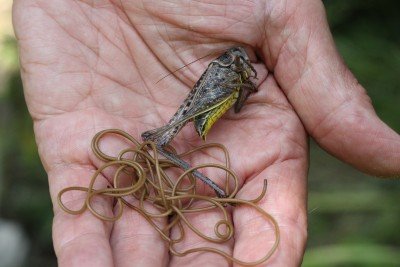
Wolf worms, specifically the larvae of the **Cuterebra** flies, are fascinating yet often misunderstood. They can invade small mammals like rabbits and rodents, where they mature. You might be wondering if it’s possible to learn about these critters without harming their furry hosts or disrupting the ecosystem they belong to. Let’s dive into this interesting topic and explore how scientists can study wolf worms while keeping their hosts safe.
Understanding Wolf Worms and Their Hosts
Wolf worms are actually the larvae of a specific type of fly known as **Cuterebra**. These larvae are notorious for burrowing into the skin of their hosts, usually small mammals. Once inside, they create a small opening through which they breathe. This unique life cycle is part of what makes studying them so interesting. However, it also raises significant ethical concerns about how to study these organisms without causing harm.
The typical hosts for wolf worms include various rodents, rabbits, and even pets like cats. Once the larvae invade, they can cause a variety of reactions in their hosts, ranging from mild irritation to serious health issues. Because of this, it’s important for researchers to find methods that allow for observation and study without causing distress or suffering to the host animals.
Here’s where the challenge lies: while wolf worms are fascinating, their life cycle is tightly linked with their hosts. This relationship can complicate efforts to study them. But through innovative approaches, we can observe these larvae and gain insights without putting their hosts at risk.
Non-Invasive Research Methods
You might be surprised to learn that many scientists today are using non-invasive techniques to study wolf worms. These methods can help researchers collect valuable data without directly harming or even disturbing the hosts. Think of it like putting a camera in the wild to capture a moment instead of trying to catch the animal.
One popular technique is using **remote imaging**. This can include everything from infrared cameras to high-resolution photography. By observing hosts in their natural habitat, researchers can monitor behaviors and interactions without the need for direct contact. This minimizes stress for the animals and provides a more accurate representation of their lives.
Additionally, researchers are leveraging **genetic sampling** techniques. Instead of removing larvae from hosts, scientists can collect small samples of tissue or other materials to analyze the genetic makeup of the worms. This opens up a whole new world of understanding regarding their life cycles and interactions with hosts, all while keeping the animals safe.
The Role of Technology in Studying Wolf Worms
Technology is transforming the way we approach wildlife studies, including those involving wolf worms. With advancements in genetic sequencing and imaging techniques, researchers can gather information that was once thought impossible. For example, researchers can now use **DNA barcoding** to identify species of wolf worms without ever needing to harm the host.
This integration of technology allows for more refined studies. Instead of relying on traditional dissection methods, scientists can understand the life cycle and behaviors of wolf worms through genetic analysis and non-invasive observations. How cool is that?
Moreover, these technologies can make ongoing monitoring feasible. By using tools like GPS tracking or even monitoring climate data, researchers can gain insights into how environment changes affect the relationships between wolf worms and their hosts. It’s like having a window into the ecosystem that’s both ethical and informative.
Ethical Considerations in Wildlife Research
When it comes to studying any creature, ethics play a crucial role. It’s not just about what can be done, but what should be done. Researchers must navigate the delicate balance between gaining knowledge and ensuring the well-being of the host animals. Luckily, many scientists are prioritizing ethical standards in their work.
One instance is the use of **institutional animal care committees**, which review research proposals to ensure minimal harm to animals. These committees help guide researchers in choosing methods that are less invasive or entirely non-invasive. Following strict ethical guidelines not only protects the animals, but it also enhances the credibility of the research.
Additionally, many researchers are committed to public education about wolf worms and their hosts. By sharing findings and promoting awareness, they can engage the community and encourage conservation efforts. This kind of transparency reinforces the importance of studying wildlife responsibly.
Potential Discoveries from Studying Wolf Worms
So, why does studying wolf worms even matter? Well, there’s a lot we can learn not just about these unique parasites, but about ecosystems as a whole. For instance, understanding wolf worm behavior and life cycles can shed light on how they affect host populations. This can have implications for wildlife management and conservation efforts.
Moreover, researching these parasites may lead to discoveries about their interactions with diseases or other pests. For example, if wolf worms have unique immune responses, studying them could inform broader medical research. Who knows? A parasite might hold the keys to breakthroughs in understanding human health issues!
The knowledge gained from wolf worm studies can function like a ripple effect, touching various fields in science. From ecology to genetics, the opportunities are endless. That’s why it’s so important to continue finding innovative and ethical methods for observation.
Studying wolf worms doesn’t have to mean harming their hosts. Through **non-invasive techniques**, advancements in **technology**, and a commitment to ethical research, scientists can gain valuable insights into these unique parasites while keeping their furry hosts safe and healthy. As we continue to explore the complexities of these relationships, we not only broaden our understanding of nature but also reinforce the importance of studying wildlife responsibly.
In the end, the path forward is one that blends curiosity with compassion. By prioritizing the well-being of hosts, researchers can unlock secrets about wolf worms that could benefit both wildlife and human health. And who wouldn’t want to learn more about these amazing creatures without causing them harm? So, here’s to more ethical explorations and exciting discoveries in the world of wolf worms!
